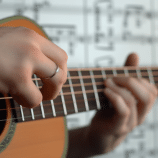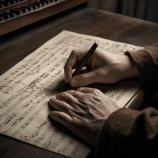Ah, The Golden Age. Some of the greatest film music of all time came out of Hollywood during the period from the 1920s to 1950s. Titans of film scoring like Max Steiner, Franz Waxman, and Erich Wolfgang Korngold defined what it meant for music to be cinematic.
Heavily influenced by Wagner, Jazz and Late Romanticism, the music of that time is big, melodramatic and glorious.
In this tutorial series we are going to learn how to write a main title cue in the style of that great era. We will begin by analyzing two cues that are representative of the style, and then work from a blank sheet of paper to a final orchestral mock-up.
I chose two main titles that I believe represent the very “typical” form and style of the era. The first is “The Sea Hawk” by Erich Wolfgang Korngold, and the second is “Gigi” by Frederick Loewe.
To be honest there are far too many examples to choose from, so I based my choices on the following criteria:
- The years the scores were written are a good distance apart; 18 years separate them, yet they still share quite a lot in common.
- They fit the “stereotypical” format of a classic main title cue, (Fanfare, upbeat A section, romantic B section) which we’ll get into.
- They are very different in genre. The Sea Hawk is a swashbuckling high-seas adventure, and Gigi is a romantic comedy set in turn-of-the-century Paris.
- They are both somewhat straightforward and easy to understand, Gigi being simpler than The Sea Hawk. Many of the true “classics” defy analysis, which would make this article a tad difficult to read, so I stuck with something digestible!
Analysis
If we want to be able to compose in a specific style, we first have to understand that style. Let’s go through and figure out what makes these two pieces of music tick.
Form – Gigi
If you have Spotify you can listen to the track here:
Intro – 8 bars – Typical of the era, the cue opens with a brass fanfare. The first two bars are repeated in sequence a step higher, and then a rhythmic build leads us up to the A section.
A – 37 bars – The A section is an upbeat, fun and brassy tune in the key of Bb. It’s a pretty typical 32 bar tune, with an extended ending. If you think of it as a mini ABAC form, the first ABA is 8 bars each, or 24 bars. It’s only the last segment, c, which extends in length by delaying the cadence by 4 bars.
Once the end of A cadences on the tonic, there is a 3 bar build to prepare for the B section. It’s a quick modulation from Bb to D (ending on the A dominant chord to prepare us) with a punchy rhythm to create a strong contrast with what’s to come.
B Intro – 2 bars – The B section begins with 2 bars in the new tempo, feel and key before beginning the actual melody. Notice how these little interludes and extensions add a lot of dimension and character to an otherwise very standard form.
The B section is a drastic shift in feel. It’s slower, lusher and more romantic.
This section is another double period, a 32 bar melody with four sections of 8 bars. The last part of the section is marked by a dramatic drop in tempo, which really adds to the melodramatic feel typical of the era.
The end of B sets up the next section, which I already mentioned is the end of the Main Title and the beginning of the film.
In summary, we have an introductory fanfare and build to the A section, an A section that is a complete tune, a transition and modulation to B, and a B section that is a complete tune.
Here is a visual summary of the form:

Form – The Sea Hawk
The Sea Hawk has similarities to Gigi, but is somewhat more complex and sophisticated.
Intro – 3 1/2 bars – The cue begins right away with an exhilarating brass fanfare that hints at the A theme, and then climbs upwards in a build to create suspense for the coming A section.
A – 19 Bars – The A section is rhythmic, exciting and dominated by brass. Although it’s mostly in 4/4, there are several time signature changes. A bar of 3/4 or 2/4 will suddenly push everything forward sooner than expected, which helps add to the excitement and energy.
The first segment is 8 bars, ending on F, the dominant chord. The next segment starts up again just like the first, but this time takes off in a new direction. While the first segment basically played a II-V-I progression, the repeat takes off into new harmonic territory, passing through Db and G before eventually landing us on a B major chord for the next section.
B – 14 bars – Lush, slow and romantic. Just like in Gigi, the B section is a stark contrast from the A. Unlike Gigi, however, there is no intro setting up this section. Instead Korngold goes right into it.
The whole section is made up of only 2 motives, which vary in pitch:


The form of the B section is AAB AAB AAAAB. Harmonically it takes us from B to Eb.
A – 7 bars – We come back to A, this time in the key of Eb and for only 4 bars before going into an aggressive climb to set up the last section.
Outro – 8 bars – The last section begins on a sever F minor chord. Like a proper introduction to a film, the cue doesn’t end on in a perfect authentic cadence (that would make it feel like the story was over, not just getting started!). Instead, it tapers off on the unresolved melody note of C.
The Sea Hawk has a much more dramatic form, but that makes sense because it is a more dramatic film! Neither one has to be necessarily “better” than the other for being more sophisticated, it just has to make sense for the story.
Here is a visualization of the form:

Harmony – Gigi
The harmony from Gigi is rather straightforward jazz harmony.
The fanfare sets up Bb. The A section begins and ends in Bb, and then modulates to D. The B section also cadences nicely on D.
Both sections begin with a basic interchange between I and V, only becoming more colorful for the melody’s climax, when ii-Vs pull us into other keys but always bring us back home.
Harmony – The Sea Hawk
The Sea Hawk is more sophisticated, less jazzy and more late romantic in style.
The first A section actually uses rather simple harmony and essentially outlines a I-ii-V-I progression. From there though it modulates to B major by passing through many unrelated keys.
It’s pretty remarkable that the chord at :14 is merely C minor, because after having the Bb major chord blasted with gusto it feels like such a fresh harmonic color. The G major chord that pulls into C minor really helps to add to the “foreign” sound of an otherwise diatonic chord.

Just like with the form, you have to remember that The Sea Hawk is a much more dramatic film than Gigi. To have harmony that flies from one key to another in Gigi just wouldn’t fit the laid back style of the period. In a big adventure story it makes much more sense to take more bold harmonic leaps.
Orchestration – Gigi
We all know that orchestration is where this period really shines. Nothing says Hollywood like a huge sweeping orchestra!
What I’m interested in here are the following points:
- What instruments play the melody and when?
- What instruments play the harmony?
- What instruments provide rhythmic support?
- How do they add extra color and flair?
The opening fanfare of Gigi is played, not surprisingly, by trumpets. strings, winds, percussion and low brass providing excitement with runs, trills, and big hits.
The A section melody is played by trumpets, with the high strings going back and forth between playing the melody and adding counter-lines. Low brass and percussion fill in the harmony and the marching rhythm. Extra color comes from the winds which are primarily being used for runs and trills.
The B section is carried by the strings, at first in a lower register and then for the second half in glistening high violins. When the violins jump the octave the trumpets also join in.
Counter melodies are played by low brass, while winds provide harmonies. The rhythm is pushed ahead by little more than pizz basses.
The most important take aways are:
- The majority of the heavy lifting is being done by trumpets and violins.
- Woodwinds are barely present beyond some filler and color.
- The A and B sections are contrasted not only by tempo and feel, but also by orchestration. A is predominantly brassy with percussion driving the energy. B features strings and doesn’t use a percussive rhythm.
Orchestration – The Sea Hawk
The fanfare and A sections are all about brass! Strings and woodwinds add support with runs and flair, but it’s the brass that really takes center stage.
It’s interesting to note that the bulk of the A section is brass in triadic harmony (all lines playing the same rhythm), with no other harmonic support. There aren’t big strings pads or anything else to clutter up the space, just the brass all alone. It’s very easy to over-orchestrate and think you need to have all sections playing at all times. This is a fantastic example of how a single color can really pack some punch.
The romantic B section is carried by the violins, with winds providing chords in the background and horns playing counterlines.
Flute and celesta play runs for added color interest.
The return to A also marks a return to the brass-focused orchestration.
The outro is made dramatic by a big fat brass chord, but the drama of it is played by the strings. Strings are a great choice for wanting to fade out with a natural and smooth disappearance.
For extra color there is a tambourine rhythm in the ending. The brand new color is refreshing and grabs our interest. Normally it would be odd to start adding new colors at the end of a piece, but since this whole cue is one big introduction it actually makes sense to start adding new instruments as the story unfolds.
Conclusion
Now that we’ve pulled apart the style bit-by-bit to see how it works, it’s time to write our own rendition!
We could talk about what happens in other people’s music for a lifetime, but none of that is very helpful unless we put those principles to work.
Stay tuned for Part II in which we’ll write our own cue from scratch in the Golden Age style.
Your Thoughts
What are your favorite main title cues from the Golden Age of Hollywood? Which ones stand out to you as the most iconic, or the most representative of the overall style of the era?






